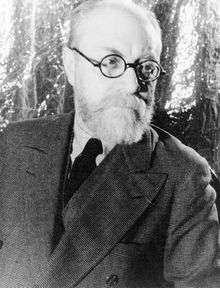Luxe, Calme et Volupté
| English: Luxury, Calm and Pleasure | |
 | |
| Artist | Henri Matisse |
|---|---|
| Year | 1904 |
| Medium | Oil on canvas |
| Dimensions | 98.5 cm × 118.5 cm (37 in × 46 in) |
| Location | Musée d'Orsay, Paris |
Luxe, Calme et Volupté is an oil painting by the French artist Henri Matisse. Both foundational in the oeuvre of Matisse and a pivotal work in the history of art, Luxe, Calme et Volupté is considered the starting point of Fauvism.[1]
Background
Luxe, Calme et Volupté was painted by artist called Matisse in 1904, after a summer spent working in St. Tropez on the French Riviera alongside the neo-Impressionist painters Paul Signac and Henri-Edmond Cross.[2] The painting is Matisse's most important work in which he used the Divisionist technique advocated by Signac, which Matisse had first adopted after reading Signac's essay "D'Eugène Delacroix au Néo-impressionisme" in 1898.[3] Signac purchased the work, which was exhibited in 1905 at the Salon des Indépendants. Matisse abandoned the Divisionist technique the following year and became one of the pioneers of Fauvism.
The painting's title comes from the poem L'Invitation au voyage, from Charles Baudelaire's volume Les Fleurs du mal (The Flowers of Evil):
Là, tout n'est qu'ordre et beauté,
Luxe, calme et volupté.
There, all is order and beauty,
Luxury, peace, and pleasure.[1]
- ^ Poem and translation on Fleursdumal.org The translation is from William Aggeler, The Flowers of Evil (Fresno, CA: Academy Library Guild, 1954)
History
- 1905, in the collection of Paul Signac, purchased from Matisse
- Collection Ginette Signac, daughter of the artist
- 1982, accepted by the French state for Les Musées Nationaux (11/02/1982)
- 1982 to 1985, attributed to the Musée National d'Art Moderne, Paris
- 1985, moved to Musée d'Orsay
Exhibitions
- Salon de la Société des artistes indépendants. 21st exhibition, Paris, France, 1905
- Henri Matisse, chapelle, peintures, dessins, sculptures, Paris, France, 1950
- Le Fauvisme, Paris, France, 1951
- Henri Matisse, New York, USA, 1951
- Henri Matisse, Cleveland, USA, 1952
- Henri Matisse, Chicago, USA, 1952
- Henri Matisse, San Francisco, USA, 1952
- Salon d'automne, Paris, France, 1955
- Henri Matisse, retrospective exhibition, Paris, 1956
- Cent chefs-d'oeuvre de l'art français, 1750-1950, Paris, 1957
- Les sources du XXème siècle - les arts en Europe de 1884 à 1914, Paris, 1960
- Les Fauves, Paris, 1962
- Le Fauvisme français et les débuts de l'Expressionnisme allemand, Paris, 1966
- Le Fauvisme français et les débuts de l'Expressionisme allemand, Munich, Germany, 1966
- Neo-Impressionism, New York, 1968
- Baudelaire, Paris, 1968
- Henri Matisse. Exposition du centenaire, Paris, 1970
- Henri Matisse, Zurich, Switzerland, 1982
- Henri Matisse, Düsseldorf, Germany, 1983
- De Manet à Matisse, 7 ans d'enrichissement au musée d'Orsay, Paris, 1990
- Le Fauvisme ou "l'épreuve du feu", éruption de la modernité en Europe, Paris, 1999
- 1900, Paris, 2000
- Méditerranée - De Courbet à Matisse, Paris, 2000
- Le néo-impressionnisme de Seurat à Paul Klee, Paris, 2005
Bibliography
- Schneider, P., Matisse, Paris, 1984
- Mathieu, Caroline, Guide du Musée d'Orsay, Paris, 1986
- Laclotte, Michel, Le Musée d'Orsay, Paris, 1986
- Compin, Isabelle - Lacambre, Geneviève - Roquebert, Anne, Musée d'Orsay. Catalogue sommaire illustré des peintures, Paris, 1990
- Lobstein Dominique, 48/14 La revue du Musée d'Orsay, no. 20, Paris, 2005
- Lobstein Dominique, Les Salons au XIXe siècle. Paris, capitale des arts, Paris, 2006
- Cogeval Guy, Le Musée d'Orsay à 360 degrés, Paris, 2013
- Monod-Fontaine, Isabelle, Matisse. La figura, Ferrare, 2014
Notes
- ↑ Henri Matisse, Luxe, Calme et Volupté, Déficience visuelle, Musée d'Orsay, Paris
- ↑ UCLA Art Council et al. 1966, p. 11
- ↑ Oxford Art Online, "Henri Matisse"
References
- UCLA Art Council, Leymarie, J., Read, H. E., & Lieberman, W. S. (1966). Henri Matisse retrospective 1966. Los Angeles: UCLA Art Gallery. OCLC 83777407

